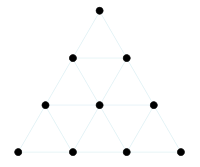10
Appearance
(Redirected from 1 E1)
| ||||
|---|---|---|---|---|
| Cardinal | ten | |||
| Ordinal | 10th (tenth) | |||
| Numeral system | decimal | |||
| Factorization | 2 × 5 | |||
| Divisors | 1, 2, 5, 10 | |||
| Greek numeral | Ι´ | |||
| Roman numeral | X, x | |||
| Roman numeral (unicode) | X, x | |||
| Greek prefix | deca-/deka- | |||
| Latin prefix | deci- | |||
| Binary | 10102 | |||
| Ternary | 1013 | |||
| Senary | 146 | |||
| Octal | 128 | |||
| Duodecimal | A12 | |||
| Hexadecimal | A16 | |||
| Chinese numeral | 十,拾 | |||
| Hebrew | י (Yod) | |||
| Khmer | ១០ | |||
| Armenian | Ժ | |||
| Tamil | ௰ | |||
| Thai | ๑๐ | |||
| Devanāgarī | १० | |||
| Bengali | ১০ | |||
| Arabic & Kurdish & Iranian | ١٠ | |||
| Malayalam | ൰ | |||
| Egyptian hieroglyph | 𓎆 | |||
| Babylonian numeral | 𒌋 | |||
10 (ten) is the even natural number following 9 and preceding 11. Ten is the base of the decimal numeral system, the most common system of denoting numbers in both spoken and written language.
Linguistics
[edit]- A collection of ten items (most often ten years) is called a decade.
- The ordinal adjective is decimal; the distributive adjective is denary.
- Increasing a quantity by one order of magnitude is most widely understood to mean multiplying the quantity by ten.
- To reduce something by one tenth is to decimate. (In ancient Rome, the killing of one in ten soldiers in a cohort was the punishment for cowardice or mutiny; or, one-tenth of the able-bodied men in a village as a form of retribution, thus causing a labor shortage and threat of starvation in agrarian societies.)
Mathematics
[edit]Ten is the smallest noncototient number.[1] There are exactly 10 small Pisot numbers that do not exceed the golden ratio.[2]
Decagon
[edit]A ten sided polygon is called a decagon.
List of basic calculations
[edit]| Multiplication | 1 | 2 | 3 | 4 | 5 | 6 | 7 | 8 | 9 | 10 | 11 | 12 | 13 | 14 | 15 | 16 | 20 | 25 | 50 | 100 | 1000 |
|---|---|---|---|---|---|---|---|---|---|---|---|---|---|---|---|---|---|---|---|---|---|
| 10 × x | 10 | 20 | 30 | 40 | 50 | 60 | 70 | 80 | 90 | 100 | 110 | 120 | 130 | 140 | 150 | 160 | 200 | 250 | 500 | 1000 | 10000 |
| Division | 1 | 2 | 3 | 4 | 5 | 6 | 7 | 8 | 9 | 10 | 11 | 12 | 13 | 14 | 15 |
|---|---|---|---|---|---|---|---|---|---|---|---|---|---|---|---|
| 10 ÷ x | 10 | 5 | 3.3 | 2.5 | 2 | 1.6 | 1.428571 | 1.25 | 1.1 | 1 | 0.90 | 0.83 | 0.769230 | 0.714285 | 0.6 |
| x ÷ 10 | 0.1 | 0.2 | 0.3 | 0.4 | 0.5 | 0.6 | 0.7 | 0.8 | 0.9 | 1 | 1.1 | 1.2 | 1.3 | 1.4 | 1.5 |
| Exponentiation | 1 | 2 | 3 | 4 | 5 | 6 | 7 | 8 | 9 | 10 |
|---|---|---|---|---|---|---|---|---|---|---|
| 10x | 10 | 100 | 1000 | 10000 | 100000 | 1000000 | 10000000 | 100000000 | 1000000000 | 10000000000 |
| x10 | 1 | 1024 | 59049 | 1048576 | 9765625 | 60466176 | 282475249 | 1073741824 | 3486784401 | 10000000000 |
Science
[edit]The metric system is based on the number 10, so converting units is done by adding or removing zeros (e.g. 1 centimetre = 10 millimetres, 1 decimetre = 10 centimetres, 1 meter = 100 centimetres, 1 dekametre = 10 meters, 1 kilometre = 1,000 meters).
Mysticism
[edit]
- In Pythagoreanism, the number 10 played an important role and was symbolized by the tetractys.
See also
[edit]Notes
[edit]References
[edit]- ^ "Sloane's A005278 : Noncototients". The On-Line Encyclopedia of Integer Sequences. OEIS Foundation. Retrieved 2016-06-01.
- ^ M.J. Bertin; A. Decomps-Guilloux; M. Grandet-Hugot; M. Pathiaux-Delefosse; J.P. Schreiber (1992). Pisot and Salem Numbers. Birkhäuser. ISBN 3-7643-2648-4.
External links
[edit]Wikimedia Commons has media related to 10 (number).
Look up ten in Wiktionary, the free dictionary.
